The first generation Citroën C1 has sold well, with just over three quarters of a million units registered. The model is part of a joint offer of Citroën, Peugeot and Toyota, under the names C1, 107 and Aygo, respectively. In 2009 came a facelift with changes in aesthetic details and equipment options, and another update to withstand replacement in 2012.
A deeper renewal, the second generation, was presented in 2014 at the same event where he saw the light in 2005: the Geneva Motor Show. After almost ten years on the market a change was necessary, although I do not know if so deep. I say this because beyond the aesthetic remodeling of turn and the incorporation of new technologies, the second generation Citroën C1 has received a new 1.2 three-cylinder engine with 82 hp, clearly more powerful than the 1.0 of Toyota origin and 68 hp. The diesel engine has been discontinued.
With the background of having driven the first generation several thousand kilometers, my debut testing for Pistonudos will be on the back of the model with more rock & roll of the second generation: the Citroën C1 Airscape.
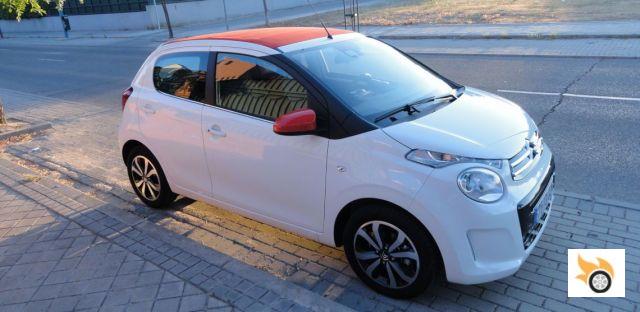
Design
If in the equation of reasons why I liked the first generation of the C1 the design was not one of them, in the second generation there has been a turnaround. The bland look of the 2005 model didn't improve much with the 2009 restyling, however in the latest version the car has gained in personality. Now it's easier to distinguish a C1 from a 108 or an Aygo, as they are more distinct from each other.
The front end breaks with the previous concept on several fronts. The logo, as with other models of the brand, leaves the insulation to be integrated into the upper air intake. The front light clusters are no longer a block and are distributed: the position lights and indicators border the front hood, the main lighting -crossing and road- slightly lower its primitive position and the daytime running lights are located in a low position and as lateral as the front of the car allows.
Design, colour combinations and small details give the Citroën C1 Airscape its personality.
The side view gains in detail and chromaticism. While in the first generation and its evolution of 2009 the side of the car was flat, both in shape and color, now breaks that aspect playing with several elements. On the one hand there are two folds in the sheet metal, an upper one on whose line are located the door opening controls, and a lower one, located slightly above the edge closer to the floor of these. The resulting appearance is more three-dimensional.
As for the color, the body color is enhanced by the different color of the mirrors, the touch of black on the A and B pillars, as well as part of the front door frame. In the case of the Airscape version we also have the different tone of the hood and in some equipment packages, the lower frames of the windows are chrome. The access cover to the fuel tank has slightly changed its position and, above all, its shape: it is now completely round. Add to that the 15-inch aluminium alloy wheels and you have the complete picture of a striking, modern side profile in line with current design trends. This compendium of details stands out against the sobriety of the side of the first generation, where only broke the monotony of the side strip that served as an element of protection of the doors.
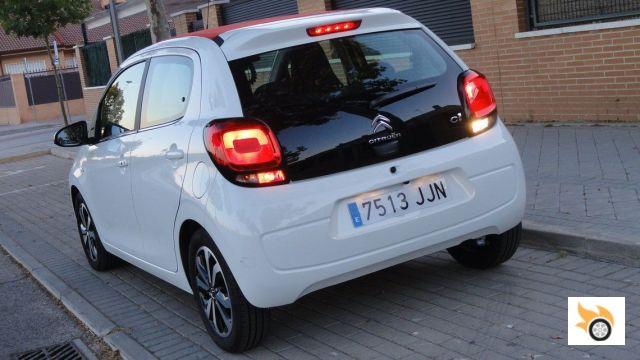
The rear of the second-generation C1 has also undergone a remarkable metamorphosis. Starting at the top, we now find an aerodynamic element that integrates the central LED brake lights, which occupy a similar position to those of the first generation. The bulky hinges of the original hatch disappear from view. At mid-height we notice the absence of the colourful and oblong rear light clusters, replaced in the second generation by almost square clusters, which invade the side of the car a little more than before and whose lower edge is a continuation of the lower glass edge of the tailgate. All the optical elements, even the reflectors, are located within the same set, with the aforementioned exception of the central brake lights for reasons inherent to their homologation.
The part of the body that acts as a rear bumper gains in height, is no longer two-tone, and integrates the hole for the license plate. As for the transparency of the glass, it is less differentiated than in the first generation. Finally, the finish of the exhaust pipe continues to be discreet to the eye; you have to try a little harder to find it.
The interior of the new Citroën C1 has also changed, and a lot, but we will see that in its corresponding section. The 86% score awarded to the test model in the "Design" section is based both on the result achieved and on the ability of the designers to give a new twist to a concept that was visually unattractive and outdated in time.
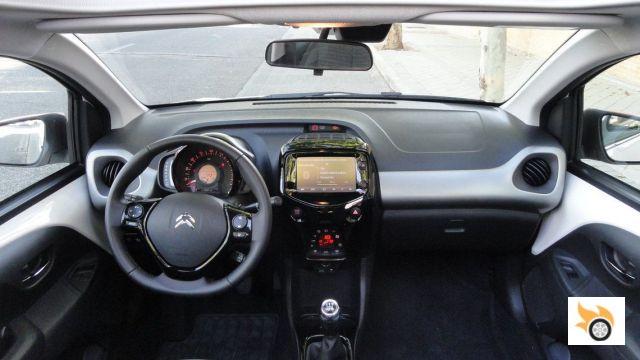
Cabin
If the external changes of the second generation Citroën C1 are more than obvious, when sitting for the first time inside the new model, knowing the first, the feeling is that we are in another world, and indeed it is so; it is another car.
In the driving position, the only noticeable quick coincidences are the air vents: they are still round... The rest is radically different! Even the steering wheel has abandoned its circular shape. The differences are so pronounced that I've given up the detailed comparison to focus on describing what's there. The second generation Citroën C1 abandons simplicity and exoticism in the dashboard, disappearing the primitive orbital tachometer, which did not always come standard. The information we receive from three distinct areas.
The main one corresponds to the element located on the steering column. Here we have a circle that houses a traditional needle speedometer with circular movement. In the center of the same information is displayed by digits provided by the on-board computer, in addition to the fuel level in a semicircular segment divided into six sections. Forward, reverse and resetting of the various parameters is done by two needle-type push buttons, which require you to put your hands inside the steering wheel rim.
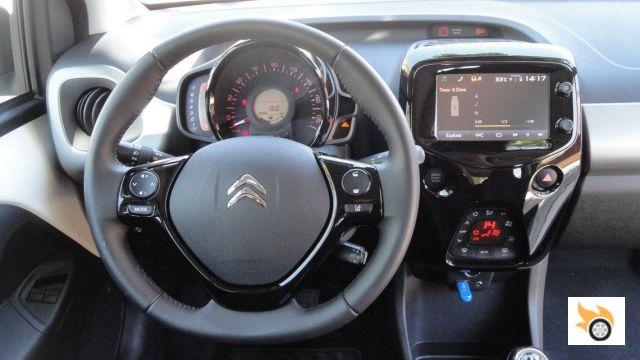
Between the larger circle of the odometer and the smaller circle of the computer there are a number of indicator lights such as "door open", handbrake, seat belts or ABS, to name a few. These are distinguished by colour: blue and green for lighting, orange for caution and red for more serious problems.
The central circle is flanked by two side sections. Each of these side elements displays information: the one on the left houses a digital tachometer that shows the engine revolutions by a sequence of light stripes flanked by a corresponding scale. The one on the right is divided into three zones. The upper one contains the indicator lights for the most critical engine situations: low oil level or engine coolant overheating. In the middle, a "green-friendly" warning light indicates the need to change gear ratios to reduce fuel consumption. The lower one returns to red, both to indicate engine stop and electrical anomalies. If the unit is equipped with intelligent door opening control, there we will also have his witness, but in orange. The system as such seems most didactic: if you see a green light out of the corner of your eye, change gear. If you see a red flash, start shaking.
One of the attractions of the Citroën C1 Airscape is the 7″ multifunction touchscreen.
The second piece of visual information is provided by one of the main new features of this second generation: the seven-inch multifunction touchscreen, an element that nowadays seems essential - you have to be connected to the world! This screen brings together several functions: external thermometer, telephone connection, car information, infotainment and, when available, it acts as a screen for the rear camera. The phone connection is via Bluetooth; if your phone is compatible, connection is simple. Once connected, we can not only make and receive hands-free calls (a function accessible from the controls on the right spoke of the steering wheel), but also access other functions such as contact lists and SMS messaging. This connection also allows you to play music that is recorded in the memory of the smartphone or via the Internet (Bluetooth Audio). As for information about the car, consumption and route statistics are displayed in graphic mode.
The infotainment section of the Citroën C1 is a bit peculiar. In itself, it only includes a radio. Other sound sources are accessible via the aforementioned Bluetooth Audio and the only USB connection available. In our test it read MP3 files from a USB stick without any problems. There is no CD player. In the first generation it had a radio, CD player (without MP3) and an auxiliary connector for external sources. The leap is more than obvious. It can't be criticized for the lack of a disc reader, having USB and BT Audio, which is the most used nowadays.
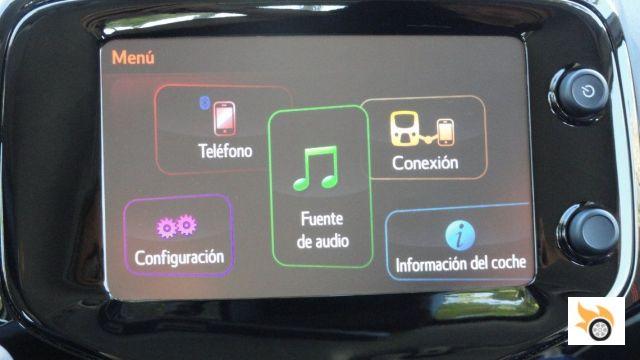
The system is compatible with MirrorLink, a connection standard via USB cable that allows, in theory, to display on the screen applications that are running on the smartphone and that are also compatible with MirrorLink. Here we can find GPS navigators (like iCoyote or Sygic), music platforms (Spotify, RockScout, etc), travel and local information, and some more. This opens the C1 to an incredible set of possibilities, but with an important "but": the list of smartphones compatible with MirrorLink is quite limited and limited to high-end phones.
This means that if the owner of the Citroën C1 has one of these smartphones, it's a no-brainer. Otherwise, he should think about adding several hundred euros to the price of the car if he wants to listen to his Spotify playlist or access a good GPS navigator, such as Waze. Some of these apps are free, but premium services are not. Three different smartphones running at least Android 5.x (fully compatible with the aforementioned apps) were used in the test, and there was no way. The rating in this chapter, which you will see below, is: 55%, the minimum for a radio and USB input. MirrorLink and ease of use add up to the other 5%.
Let's continue with the rest of the dashboard.
The third important piece of information is the one dedicated to the climate control system. It consists of a small display that shows the target temperature of the system, along with the activation status of the various elements that make it up. This screen is flanked around its perimeter by the controls necessary to activate/deactivate the various functions (temperature, fan, air conditioning, heated window, etc.). On the upper part of the dashboard, in the central area, there is another small screen that provides information related to the airbags by means of indicator lights. This way you can find out whether or not the passenger airbag has been activated, which is very important if a rear-facing child seat has been installed.
Moving on, let's move on to the steering wheel. I mentioned that it is no longer perfectly round. The second generation of the C1 offers a steering wheel that is slightly straight at the bottom so that it doesn't bother your legs. In addition to the usual satellite controls for lights, wipers and speed (badly arranged, to be honest), there are other controls on the two main spokes, mainly related to the touchscreen and phone functions.
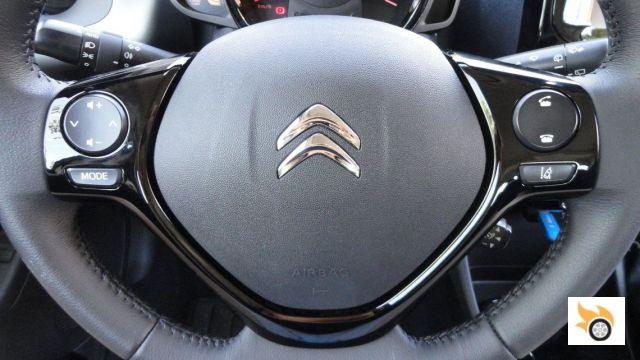
As the pedals are still three in manual gearbox models and is another of the few things that do not change radically, at least in its functional part, there they stay. What I don't overlook are the differences in the seats. The second generation, more "marching" in terms of chromaticism - depending on equipment levels - can be colored in different ways. This is a matter of taste, but the shape and comfort is not.
I admit that the bones deteriorate noticeably when you pass the age of 45. A decade after living the first generation Citroën C1 on trips of 600 km or more, with an acceptable comfort, I found that, in the second generation, at 200 km I started to be fed up with the car. And not only me, my companion, notably younger, had the same symptoms. This is one of the chapters in which the 2014 C1 has gone backwards, considering that the seats of the previous model were not a prodigy in comfort for its poor padding. It's not the only area for improvement.
As for the second-generation Citroën C1's roominess, I don't think you can get much more out of its dimensions. It's a four-seater, more like a 2+2. The front seats fit two adults who don't play in the NBA. However, if you're not careful, when changing gear the passenger can get an involuntary nudge if one of the passengers is of a strong build. I measured the rear seats as follows: with the driver's seat adjusted to my height (1.70 m) I tested the space behind me and sitting as upright as possible, I missed the front seat backrest with my knees by a couple of centimetres. I had to raise the headrest to its maximum position to avoid pinning it in my back and the distance from the head to the ceiling was less than three fingers. In such a forced position, a trip of more than 50 km can be delicate. Now play with your height and the height of the people who could get into the back of the C1. There you have the answer. In terms of storage space, the glovebox now has a lid and, in general, the limited space available is well used.
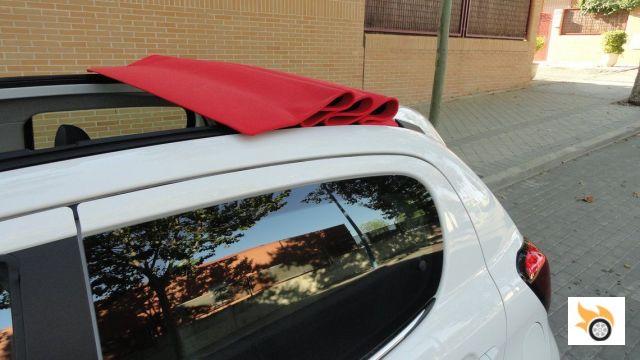
The distinguishing feature of the Citroën C1 Airscape is the folding roof. It is striking how solid this element looks when viewed from the inside and how fragile it appears from the outside. It is neither solid nor fragile. The soft top is removed in 9.5 seconds and does not take up any useful space elsewhere in the car when opened. However, if you have a passenger behind you who is over 1.72 metres tall and combs his hair pincho-style, it's a good idea to warn him or her that you're going to stay in convertible mode, lest some hairs get caught in the folds of the soft top. As for the additional aerodynamic noise that arises from the open top, this is a matter of taste. There are those who are comfortable with sound system noise levels bordering on eardrum rupturing for themselves and others. For this type of driver, I'm afraid it won't make any difference whether or not the soft top is deployed.
For lovers of the sound of silence, having the roof open in the city (the use, in my opinion, more advisable), will not mean extra noise. Between the sound of the engine and the voices of the street, aerodynamic noises are not remarkable. Driving on the road and at more than 80 km / h, the thing changes and here the aversion to noise does intervene. As I said, it's a matter of taste. In any case, except for the novelty of testing the invention or showing it off for a while with friends, I do not recommend its regular use on the road; it can be uncomfortable and the outer edges -in the form of a beak- of the front of the hood can end up damaged over time (they are exposed and suffer a significant pressure).
It's the engine bay's turn. Everything is adjusted to the maximum and that brings a drawback: the bonnet's fastening rod is very exposed to the heat of the engine, it's metallic and has no plastic protection. If you lift the bonnet with the temperatures we are having this summer, be careful, you can leave your fingers stuck to the rod.
As for the trunk, 196 liters of capacity is the minimum without folding the rear seats. It can hold a couple's weekly shopping, or a small suitcase and a couple of handbags for travelling. With the rear seats folded down the available volume is 780 litres. Two small hooks on the side allow a couple of small bags to be carried.
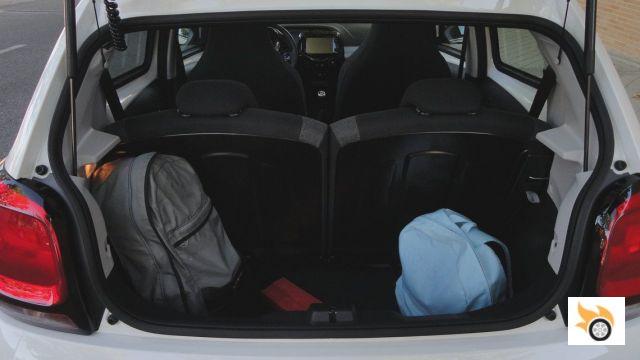
Technology
The Citroën C1 Airscape in this test is powered by the most powerful petrol engine in the C1 family, the PureTech 82, with enough power (82 bhp at 5750 rpm) to move the 956 kg the car weighs in running order. Torque is 118 Nm at 2750 RPM. The 1,199 cc engine is positioned in a transverse front position. Both the block and cylinder head are made of aluminium alloy. Two camshafts in the cylinder head operate the four valves per cylinder and the fuel supply is by indirect injection. So far so good, although I have deliberately omitted one piece of information: the number of cylinders, and there are three.
It won't be the last time I say it: I don't like three-cylinder engines. Not in this car, not in any car. In the more than 100 years of automotive history, advances have been made by adding, not subtracting (except for discomfort and weight). A starter motor was added to avoid the occasional broken arm trying to start the engine. The leaf springs were replaced by suspension systems more empathetic to the kidney of the occupants. And so a thousand things like ABS, traction control or air conditioning. Always adding up. Eliminating cylinders only adds to the bottom line of manufacturers, who want to convince us that this is good. And it is not. They are not always more efficient engines, or quieter, or cheaper for the user. The only thing they add for the user are vibrations, which in the long run can translate into breakdowns -of the engine or any other component- and always in discomfort for the driver and occupants.
Having said that, you can imagine that all the brilliance that the power figures and any other feature mentioned above, is diluted by the "three-cylinder". It's one of the big new features of the second generation Citroën C1, and the model's darkest shadow. The homologated consumption is far from the real, which is 49% higher and the machine is noisy, sounding like "something badly adjusted". The same thing happens in the 1.0 of Toyota origin, also three-cylinder, in this segment are not styled the same measures of isolation that in higher segment. In the A-segment, almost all petrol engines are already like this.
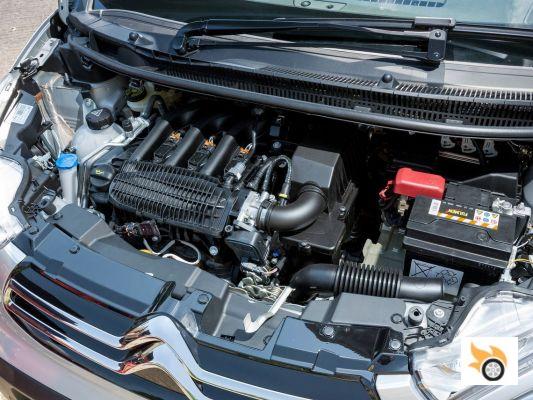
The Citroën C1 Airscape is far from being a lighter. On the road section of the test, driving with the gear change indicator on and without exceeding the speed limits of the different sections (50 km/h on a mountain pass and 120 km/h on a toll motorway), the on-board computer showed a fuel consumption of 6.1 litres/100 km. It so happens that I did the same section many times with the first generation C1 diesel (1.4 litres displacement, two valves per cylinder and turbocharger), without so much regard for gear changes, with fuel consumption ranging from 4.3 to 4.5 litres/100 km. As for city traffic, exceeding 7 litres/100 km is not exceptional with average congestion and using air conditioning.
Let's move on to the transmission, suspension and brakes. The Citroën C1 Airscape is a front-wheel drive car equipped with a 5-speed manual gearbox. The clutch type is a dry single-plate clutch and the mechanism type is a gear pair. There is an automatic gearbox, actually a robotised manual - called ETG - associated exclusively with the 1.0 68 bhp engine. The front suspension is McPherson type with coil springs and the rear suspension is a wheel with a torsional element and coil spring. The front suspension has a stabilizer bar, and the rear suspension does not. So far nothing out of the ordinary in a car of this category. The brakes have 247 mm ventilated discs at the front and 200 mm drums at the rear. The steering is rack and pinion with electric assistance, variable according to speed. The tyres are the same at the front and rear (165/60 R15 77H) and the wheels are 15".
The Citroën C1 Airscape has a good package of active safety features: ABS (anti-lock braking system), AFU (emergency brake assist), ESP (stability control), ASR (traction control) and hill start assist.
Driving
The Citroën C1 Airscape is an A-segment car, a small car intended for general urban use and for the occasional trip outside the city. The test was carried out with this in mind. First, a 235 km trip divided as follows: 10% city, 45% motorways and dual carriageways and 45% on national roads with some mountain passes. The rest, about 130 km, was done on short city routes (about 5-6 km), with traffic lights, traffic jams, parking searches and all the benefits of a big city, with 35 ºC in the shade.
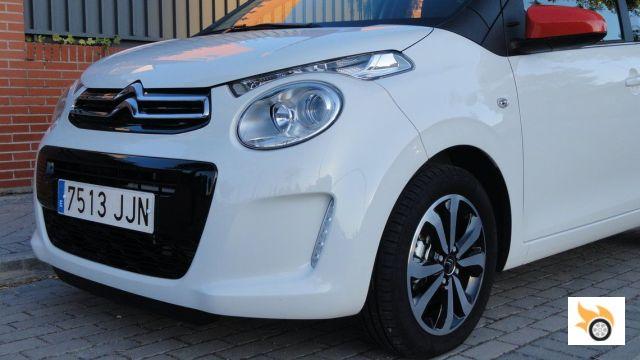
The Citroën C1 Airscape has two distinct behaviours: it's sharp at low engine speeds and smooth going forward. In the city, where it is supposed to be at its best, you have to be very careful with the accelerator, clutch and brakes if you want to take grandma for a ride (in the passenger seat, obviously). The engine is rough, the clutch too. The air conditioning adds more complications to the smoothness and the constant use of the brake, typical of the city, forms an equation that complicates the handling of the car and requires concentration so that grandma doesn't get out of the car and disinherit us. To this bad boy behavior must be added the suspension, somewhat hard and without dissimulation when it comes to transmit those bumps that you find in any industrial estate or ring road surface worn by the passage of trucks.
The gearbox handles with precision and the lever shifts through the gears without any difficulty, with a good amount of travel. The C1 brakes well, although a little more progress would be appreciated. On the road things change. In 5th gear at 2,900 RPM it reaches 110 km / h of marker (105 km / h real, measured with independent GPS). Although the engine is noisy and the hood introduces its own aerodynamic noises, you can hold a conversation without raising your voice at 120 km/h. At the same pace, the 68bhp 1.0 is higher revving and noisier.
One detail that surprised me was the great sensitivity to wind. On a couple of occasions, driving on the motorway, a frontal gust of wind acted on the Citroën C1 as if it had stepped on the brake. Checking the surrounding vegetation at the time, the gust was not such as to have that effect on any other car.
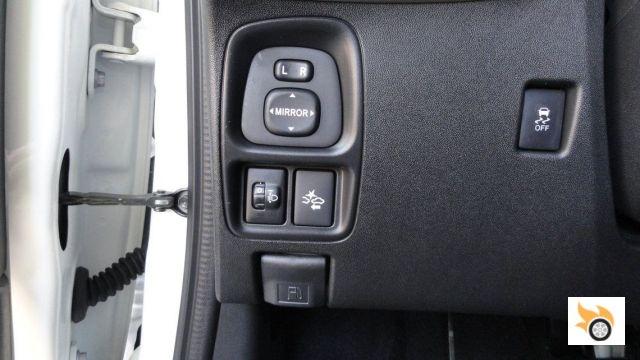
The dimensions of the Citroën C1 make it very agile in the city, as well as on winding roads, and the "defect" of the hardness of the suspension for the city becomes a virtue when negotiating curves; the car grips the ground very well. The same happens with the behaviour of the braking system; on complicated roads it works very well.
This character, which may seem uncomfortable for a certain group of quiet drivers, is fun if the bad boy is the driver (and he's driving alone or with another of a similar character). I don't mean hooligan or racing out of bounds, but to positively value the immediacy of engine response, clutch, suspension and brakes. Climbing the Puerto de los Leones (N-VI), without exceeding the speed limit at any time, the little urbanite left the rest of the troop that circulated there. Of course, my passenger didn't see it with the same eyes, although at no time was the car at the limit of adhesion, which is far from the uses of a normal driver and a naughty one (within an order).
It was not possible to test it in rainy conditions, the sky did not kindly gift us with a single drop of water, although it was possible to check the good work done by the monobrazo wiper when pouring on the glass the strong jet of water from the automatic wash. The air conditioning, however, did have a chance to shine. Above 35 ºC in the shade and up to almost 40 ºC that we got to suffer, the system was fair, although not scarce.
As for the illumination, it is more than enough to drive on intercity roads in any condition, except fog. Since we're talking about visibility, it's good forwards and backwards. The exterior rear-view mirrors cover the angles well, although the interior is somewhat lacking.
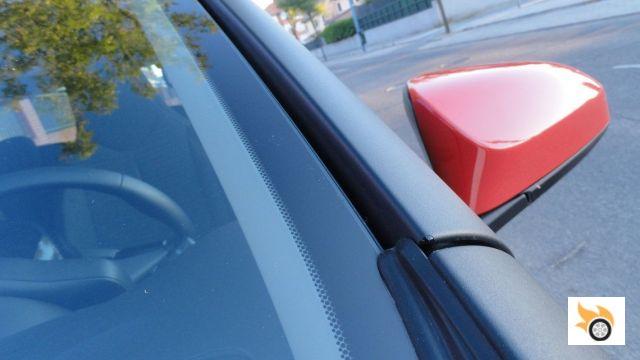
Conclusions
The Citroën C1 Airscape is a car that brings together, within its contained measures, as many bright lights as dark shadows. In the chapter of the light we have the design, as original as attractive. The performance of the car is also brilliant within its category, although the ways that are spent to get them have a tendency of sun and shadow; there are those who will value the speed of response and those who will consider it abrupt. The objective evaluation of the mathematical formula we use does not coincide here with the subjective one. The first considers the acceleration factor in two sections and in the second I take into account that the C1 is not a racing car, but a vehicle for the city, although it has a feisty character and can be fun to drive, paying, yes, the toll of consumption. An original car in its shapes and colors, with a nervous behavior not without rock & roll, give it the "pistonudo factor" that you can see below.
The shadows are also important: three-cylinder engine, rough for the destination that is supposed and a comfort very on the edge of fair. The infotainment system assumes that the owner has a latest generation smartphone, when normally this is not the case. Too bad that advanced connectivity standards are not available for older versions of such phones.
The factors that decide the purchase of a car have an important irrational component: the product enters or does not enter through the eyes for many reasons. Those who know how to appreciate what it offers and do not consider particularly important the shortcomings, can find in the Citroën C1 a car with more than enough nuances and emotions.

























